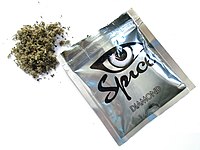
Photo from wikipedia
Synthetic cathinones, commonly referred to as "bath salts", are powerful amphetamine-like psychostimulants, and new derivatives are constantly appearing in the illicit market to evade judicial consequences. To keep up with… Click to show full abstract
Synthetic cathinones, commonly referred to as "bath salts", are powerful amphetamine-like psychostimulants, and new derivatives are constantly appearing in the illicit market to evade judicial consequences. To keep up with these new stimulant drugs, a low-sample-size liquid chromatography-tandem mass spectrometry (LC-MS-MS) method was validated to quantify 30 synthetic cathinones in postmortem blood including N-ethylpentylone and eutylone. Mixed mode cation exchange solid-phase extraction using 0.25 mL postmortem blood was performed followed by detection using a triple quadrupole mass spectrometer operating electrospray ionization in positive mode. The reversed-phase chromatographic separation was achieved in 16 min, resolving all isobaric compounds. The linear range of the calibration curve was 1 to 500 ng/mL (R2 > 0.99) for all compounds. LOQ and LOD were determined to be at 1 ng/mL. Both imprecision and bias were evaluated and had met all allowed criteria (CV and bias < 20%). No matrix effect was observed with values ranging from -5.1 to 13.3% (CV 11.4-17.5%, n = 10). Extraction efficiency (84.9 to 91.5%) and process efficiency (86.1 to 102.6%) were satisfactory, except for 4-chloroethcathinone which was 63% and 64.9%, respectively. No carryover after the upper limit of quantification was detected. Neither endogenous nor exogenous interferences were observed. Both dilution integrity and stability (24 hours) yielded acceptable results. This method was applied to 18 postmortem cases received between 2015 and 2019. Eight different synthetic cathinones were detected in selected postmortem cases within the past five years, showing a wide range of concentrations from 1.4 to > 500 ng/mL. While ethylone and methylone were detected in 2015, cases between 2016 and 2017 were predominantly butylone, dibutylone, pentylone and N-ethylpentylone which had also exhibited a significant increase in 2018. To our knowledge, this method is the most comprehensive methodology for the determination of up-to-date synthetic cathinones currently available in whole blood.
Journal Title: Journal of analytical toxicology
Year Published: 2020
Link to full text (if available)
Share on Social Media: Sign Up to like & get
recommendations!